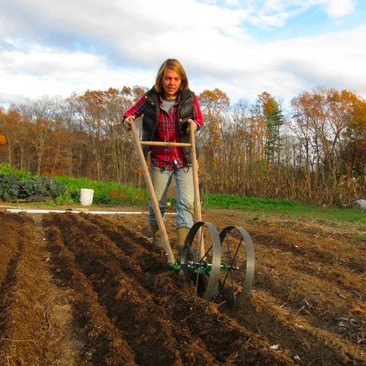
8 Ways to Be Green(er) in the Garden
 To plant a garden is to celebrate earth day every day. Earth Day proper, though, is helpful for bringing focus to the parts of our lives where we could be better environmental citizens. Driving less, saying no to plastic shopping bags, or taking fewer long, hot showers are common and useful Earth Day resolutions, but another place for improvement that is so easy to overlook is the garden. Even the greenest-thumbs aren’t always green. It’s easy to get swept-up in dreams of home-grown harvests and forget the finite or polluted resources that might be used to obtain them; forget that organic choices matter not just on your plate, but have a powerful, reverberating impact through every part of the eco-system you steward in your garden. So, to celebrate Earth Day, we are sharing a few reminders for how we can all go green(er) in the garden:
To plant a garden is to celebrate earth day every day. Earth Day proper, though, is helpful for bringing focus to the parts of our lives where we could be better environmental citizens. Driving less, saying no to plastic shopping bags, or taking fewer long, hot showers are common and useful Earth Day resolutions, but another place for improvement that is so easy to overlook is the garden. Even the greenest-thumbs aren’t always green. It’s easy to get swept-up in dreams of home-grown harvests and forget the finite or polluted resources that might be used to obtain them; forget that organic choices matter not just on your plate, but have a powerful, reverberating impact through every part of the eco-system you steward in your garden. So, to celebrate Earth Day, we are sharing a few reminders for how we can all go green(er) in the garden:
 Reduce Plastic. True, shopping at the garden means no new plastic bags, but plastic can still sneak in, and in quantity. Seed-starting flats and pots are the biggest culprits. If you are already using them, treat them with care so they can be reused as many times as possible. Be sure to disinfect them between each use to prevent the spread of disease. If you are just starting out, or ready to phase out of plastic pots, try using soil blocks or peat pots as plastic-free alternatives. For a container gardens, consider constructing wooden beds, or using recycled materials, such as the fabric planters in our catalog, which were once plastic bottles but are now durable, long-lasting plant pots. Other ways plastic can infiltrate the garden is through greenhouse covers and weed barriers - corn-based fabrics are available alternatives, as are cold frames.
Reduce Plastic. True, shopping at the garden means no new plastic bags, but plastic can still sneak in, and in quantity. Seed-starting flats and pots are the biggest culprits. If you are already using them, treat them with care so they can be reused as many times as possible. Be sure to disinfect them between each use to prevent the spread of disease. If you are just starting out, or ready to phase out of plastic pots, try using soil blocks or peat pots as plastic-free alternatives. For a container gardens, consider constructing wooden beds, or using recycled materials, such as the fabric planters in our catalog, which were once plastic bottles but are now durable, long-lasting plant pots. Other ways plastic can infiltrate the garden is through greenhouse covers and weed barriers - corn-based fabrics are available alternatives, as are cold frames.
Make organic choices everywhere. Here at the Seed Library, we’ve written extensively about the importance of using organic seeds and the disastrous, global consequences of not. But, to grow organic seeds in soils filled with pesticides and synthetic fertilizers defeats the purpose. Remember to make organic choices at every gardening step from soil to seed to plate.
Compost. Don’t send your garden (and future soil) to the dump! Throwing kitchen scraps and garden debris into the garbage doesn’t just rob your growing space of valuable nutrients, it can also make it more difficult for synthetic trash to break down (as they disintegrate at different temperatures). If you can’t set up your own composting system, ask around at your local community garden or farmer’s market if there’s a drop-off point near you.
Collect water. As more places around the world feel the stresses of limited water, there is more incentive to use water from the sky and not from plumbing. An online search can quickly reveal many ideas and free instructions for rain water collection systems for gardens of all shapes and sizes.
 Share. A healthy community equals a healthier environment. Sharing seeds, harvests, tools, and knowledge means more gardening while using fewer resources.
Share. A healthy community equals a healthier environment. Sharing seeds, harvests, tools, and knowledge means more gardening while using fewer resources.
Garden locally. Supporting small businesses is, of course, a great way to keep money in the community and alleviate the environmental impact of global shipping. But, to garden locally, also means supporting your local pollinators, heirloom varieties, and keeping foreign pests and disease away.
Use your hands. When you can, opt for hand tools over mechanized equipment. It will cut down on your garden’s dependency on fossil fuels and may also replace the gym.
Leave (some) weeds. Although weeding is one of the most laborious and most important of garden chores, keeping a discerning eye when it comes to volunteer plants can help you steward a healthier eco-system. Consider, for example, leaving Milkweed and Bee balm intact for pollinator food and habitat. Many common weeds can also serve as a truly sustainable, zero-waste, lunch (read about foraging your weeds on our blog, or in this comprehensive and beautiful book).






